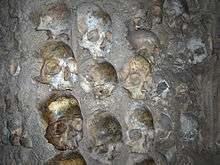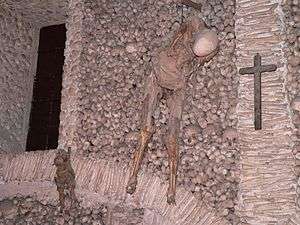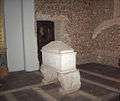Capela dos Ossos

The Capela dos Ossos (English: Chapel of Bones) is one of the best known monuments in Évora, Portugal. It is a small interior chapel located next to the entrance of the Church of St. Francis. The Chapel gets its name because the interior walls are covered and decorated with human skulls and bones.
Origin
The Capela dos Ossos was built in the 16th century by a Franciscan monk who, in the Counter-Reformation spirit of that era, wanted to prod his fellow brothers into contemplation and transmit the message of life being transitory, a very common spirituality theme summed up in the motto memento mori. This is clearly shown in the famous warning at the entrance Nós ossos que aqui estamos pelos vossos esperamos (“We bones that here are, for yours await").
Description
The chapel is formed by three spans 18.7 meters long and 11 meters wide. Light enters through three small openings on the left. Its walls and eight pillars are decorated in carefully arranged bones and skulls held together by cement. The ceiling is made of white painted brick and is painted with death motifs. The number of skeletons of monks was calculated to be about 5000, coming from the cemeteries that were situated inside several dozen churches. Some of these skulls have been scribbled with graffiti. Two desiccated corpses, one of which is a child, dangle from ropes. And at the roof of chapel, the phrase "Melior est die mortis die nativitatis (Better is the day of death than the day of birth)" (Ecclesiastes, 7, 1) from Vulgate is written.
Poem

Inside the Capela dos Ossos a poem about the need to reflect on one's existence hangs in an old wooden frame on one of the pillars. It is attributed to Fr. António da Ascenção Teles, parish priest of the village of São Pedro (wherein the Church of Saint Francis with its Capela dos Ossos was erected) from 1845 to 1848.
|
Aonde vais, caminhante, acelerado? |
Where are you going in such a hurry traveler? |
Images
 Capela dos ossos' entrance
Capela dos ossos' entrance Capela dos ossos' entrance warning ("We bones, that are here, for yours await")
Capela dos ossos' entrance warning ("We bones, that are here, for yours await") Capela dos ossos
Capela dos ossos Ossuary
Ossuary
See also
- Capuchin Crypt
- Capuchin catacombs of Palermo
- Memento Mori
- Sedlec Ossuary
- Skull Tower
- Skull Chapel, Czermna
References
| Wikimedia Commons has media related to Igreja de São Francisco (Évora). |
- Turner, J., Grove Dictionary of Art, MacMillan, 1996 - ISBN 0-19-517068-7.
- The Rough Guide to Portugal - 11th edition March 2005 - ISBN 1-84353-438-X.
- Rentes de Carvalho, J., Portugal - De Arbeiderspers, Amsterdam, 1999 - ISBN 90-295-3466-4.
Coordinates: 38°34′08″N 7°54′32″W / 38.56889°N 7.90889°W
